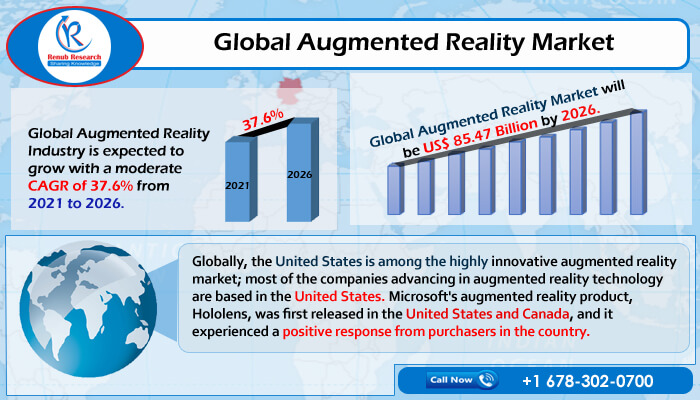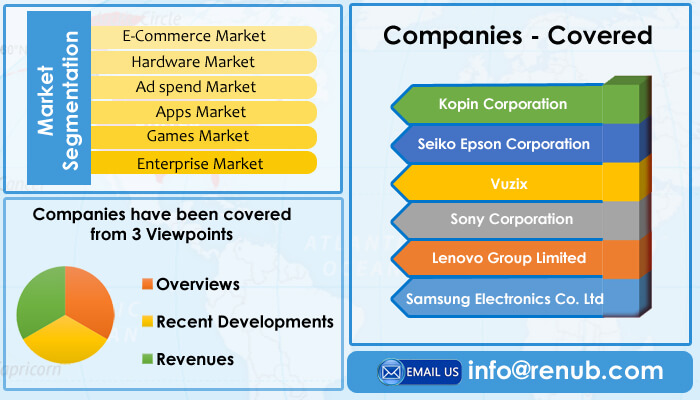Global Augmented Reality Market to Grow at 37.6% CAGR during 2021 - 2026, Propelled by Proliferation of Smartphones
07 Dec, 2021
Renub Research latest report titled "Augmented Reality Market Global Forecast by Segments, Region, End-User, Headset Volume, Company Analysis" the Global Augmented Reality Market is projected to reach US$ 85.47 Billion by 2026. Augmented Reality (AR) is a unique technology that involves the overlay of computer graphics in the real world. It only enhances objects in the modern world by superimposing virtual images into them. Augmented reality offers interactive experiences into multiple sensory, auditory modalities, including haptic, visual, somatosensory, and more. AR is a system that incorporates three essential features: a combination of real and virtual worlds, real-time interaction, and accurate 3D registration of virtual and real objects.

Factors Driving Worldwide Augmented Reality Market
Further, the global AR market is influenced by several factors, such as the proliferation of smartphones, increased popularity of gaming, cost-efficient benefits of augmented and virtual reality-based solutions, and a surge in the adoption of AR technologies by enterprises. These factors are to drive the growth of augmented reality.
Worldwide Augmented Reality Industry was US$ 12.56 Billion in 2020
Worldwide, augmented reality’s businesses continue to expand and become more pervasive among various segments like E-Commerce, Hardware, Ad spending, Apps etc. Augmented reality in the e-commerce market web design gives consumers an immersive experience, allowing real-time communication with products while remaining in their environment. Augmented reality bridge-whist the gap felt by customers between physical stores and online shopping experiences.
Moreover, the various advancements in the gaming industry, AR technologies earning much market due to it’s unlike virtual reality, augmented reality utilizes existing environment and enhances it with an overlay of distinct features. Over the last few years, the expansion of the core augmented digital reality market can be attributed to several beneficial factors, such as the proliferation of mobile apps, the increased use of smartphones, and the increasing use of digital reality in advertising.
North America is driving the Demand of Augmented Reality Market
In North America, increasing investment in immersive technologies is boosting the AR demand in the region. Similarly, the US government is keen on promoting the adoption of immersive technology, strengthening the region’s hold on the augmented reality industry. For instance, in 2019 US Defense Advanced Research Projects Agency showed interest in IMT Atlantique and contacted the company for developing similar smart contactless lenses for the US military.
Moreover, AR technology is benefiting both the enterprise and consumer industry in Asia- Pacific. The increasing usage of AR devices to improve product assortment, advertisement, catalogue management, Research and information visibility led to the selection of AR headsets among enterprises. However, the growing adoption of AR apps and smartphone users is adopted of the AR headsets product. Moreover, better field of view, technological advancements and usage of high-performance sensors at a discounted price coupled with the expanding adoption of smart glasses adopted by consumer application.
Based on headset type, the AR headsets market is segmented into standalone HMD, tethered HMD and Screen-less Viewer. The tethered HMD were the foremost or introductory tools in the industry. The AR product demand is primarily attributed to the enterprises which practice high-performance AR applications and immersive objects. In Addition, the standalone HMD comprise optical see-through, near-eye display, and LCoS technology cameras. Thus, these products provide an immersive experience without the help of any system or smartphone. Growing usage of low-price imaging sensors, microphones, and other sensors

Covid-19 has Positively Impacted Augmented Reality Demand
The COVID-19 pandemic has critically impacted global industries. It has resulted in restricted travelling, social distancing, fewer on-site staff, lack of training tools, and much more. However, AR technology offers massive support during the crisis and fuel the market potential. Increasing adoption of augmented reality technologies as more businesses have turned to remote working.
Competitive Landscape
The companies in the global AR market are receiving huge funds and investments across the globe. Companies such as Kopin Corporation, Seiko Epson Corporation, Vuzix, Sony Corporation, Lenovo Group Limited, and Samsung Electronics Co. Ltd. are collaborating with various industries to expand their markets. For instance, in 2021, Kopin ® Corporation announced a multi-year agreement with a leading Japanese electronics Company that develops superbright 2K x 2K full-color Light Emitting Diode (LED) micro displays on silicon.
Report Summary
- Segments – We have covered by segment in the Augmented Reality Market breakup by 6 viewpoints (E-Commerce, Hardware, Ad spend, Apps, Games, Enterprise), Region (North America, Europe, APAC, Rest of World)
- Region - Our Report covered by Region in the Augmented Reality Market breakup by 4 viewpoints (North America, Europe, Asia-Pacific, ROW)
- End User – Renub Research Report covered by End User the Augmented Reality Market breakup by 2 viewpoints (Enterprise, Consumer)
- Headset by Types - This report covered by Headset type the Augmented Reality volume breakup by 3 viewpoints (Screen-less Viewer, Standalone HMD, and Tethered HMD)
- All the key players have been covered from 3 Viewpoints (Overview, Recent Development, and Revenue Analysis) Kopin Corporation, Seiko Epson Corporation, Vuzix, Sony Corporation, Lenovo Group Limited, and Samsung Electronics Co. Ltd
Reach out to us
Call us on
USA: +1-678-302-0700
INDIA: +91-120-421-9822
Drop us an email at
info@renub.com